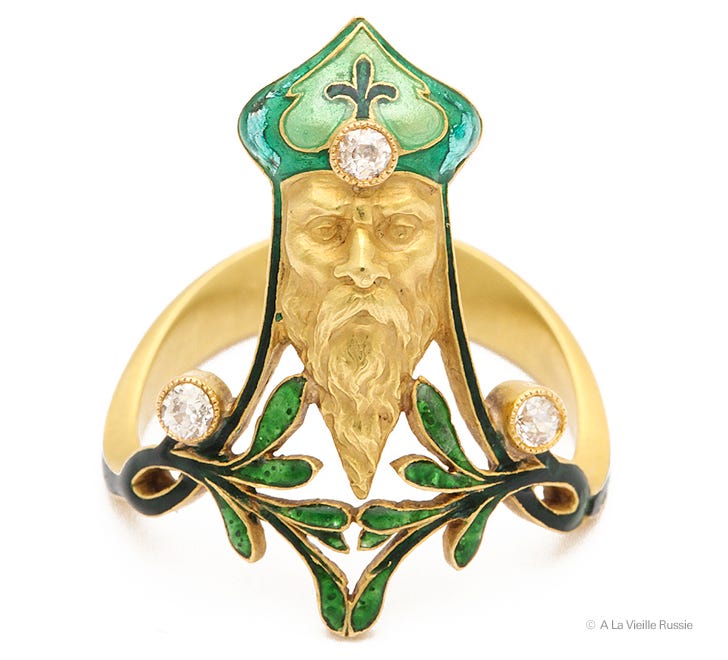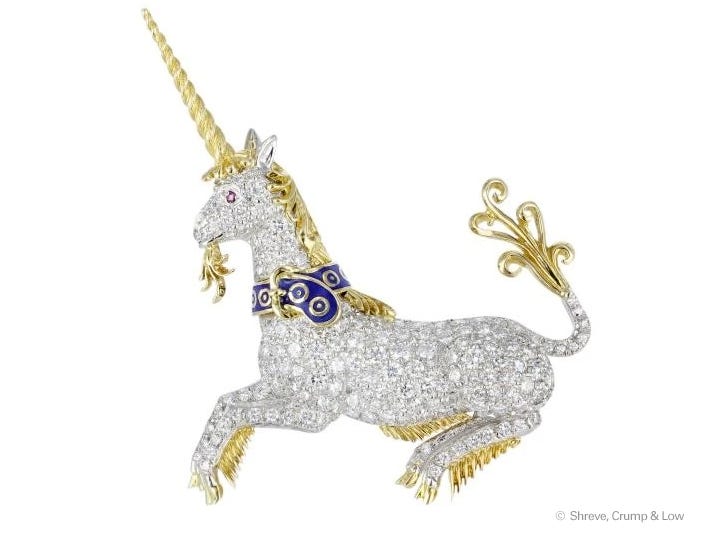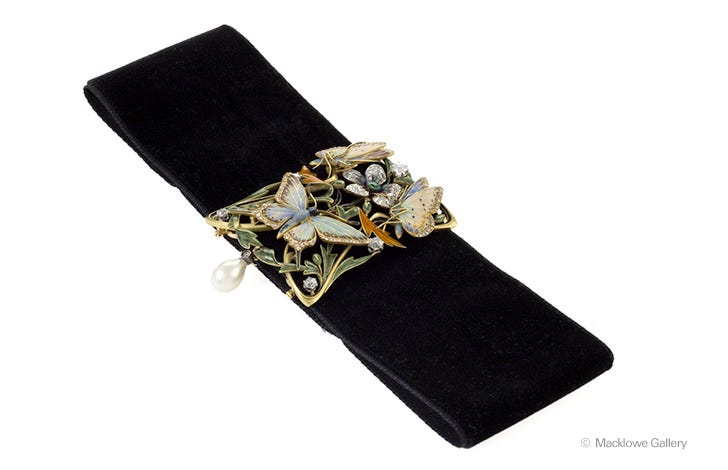Hi guys! I wasn’t planning on doing a newsletter over the holiday break because there’s not a whole lot going on, auction-wise, but I’ve come across a few fun and interesting things in my internet ramblings, so here you go!
Casa Codognato is a fourth-generation Venetian jewelry firm that has been in its current location — just steps from the Piazza San Marco — since 1866. It was started by Simeone Codognato, who, in keeping with the trends of the late 19th century, produced Etruscan-inspired jewelry, while his son favored memento mori-style pieces featuring skulls and snakes. Simeone’s great-grandson Attilio took over the company in 1958, and, despite maintaining a very deliberate low profile over many decades, has managed to rack up a devoted cult following of Important People, including Maria Callas, Coco Chanel, Ernest Hemingway, Jackie Kennedy Onassis and Elton John. Richard Burton once bought a Codognato snake bracelet for his wife, Elizabeth Taylor, and Attilio told the story to Harper’s Bazaar:
Alexandre de Paris, the famous hairdresser, saw the snake bracelet in my shop, and he told Burton and Taylor that I had this fantastic piece. Burton said, “I cannot move from my hotel because I need a drink, but I want this bracelet,” so I personally delivered it to the Gritti Palace.
Attilio — who turns 83 on Tuesday — is also very protective of the company’s legacy; he’s been known to buy back pieces and refuse to sell to customers he suspects are only in it for the investment. He also loves to pair the family flair for the gothic with a touch of mischief — I once saw a tiny engraved Codognato coffin ring that opened to reveal a skeleton with a huge, exquisitely enameled boner.
The 18k ring above is a bit more subtle, but still brilliant. Enameled in black and white Renaissance style, the piece features a ghostly memento mori skull that gazes out from beneath a window of emerald.
This 14k bangle features some truly exquisite workmanship. Circa 1850 (the turquoise section is a later addition or replacement, and dates to around 1920), it depicts a lifelike hand and wrist clad in a net glove, with intricate lines of cobalt blue enamel picking out the pattern of the fabric. The hand itself is wearing a diamond ring and a pearl bracelet set with diamonds and rubies, and is gently clasping a scroll comprised of four golden bands studded with turquoise cabochons. Elaborate Rococo-style goldwork finishes the piece below the wrist.
My favorite part, however — and also the true sign of quality workmanship — is how beautifully finished the hand is on the underside of the piece.
Circa 2015, this ring by New York-based high-end jeweler Taffin features a large hexagonal-shaped cabochon emerald in a diamond-set coiled platinum band.
“Taffin” is actually James de Givenchy, nephew of couturier Hubert and one of the leading contemporary jewelry designers in the U.S. He keeps a pretty low profile, but in 2019 he got a lot of attention after Scarlett Johansson unveiled her gigantic engagement ring at the San Diego Comic-Con. I don’t think he’s ever actually admitted to making the ring, although a nearly identical ring is on his Instagram, and the design is clearly his style — particularly the curved black ceramic band.
That ceramic is probably his main signature. The type he uses is a super durable hybrid that was originally made for watches, and he pairs it with colored stones in unexpected color combos to create some truly modern pieces. He also likes to place his stones off-kilter; sometimes upside-down or — like Johansson’s diamond and the emerald above — in an open-ended setting. This gives me agita, because I immediately imagine the rings catching on one’s clothes and then jamming into the finger or dislodging the stone, but obviously I’m just worrying about practicalities like the poor person I am.
Anyway, have a root though his Instagram; some of it is a bit much, but I would basically cut you for this ring. He also has a cute dog.
Circa 1890, this French Art Nouveau ring depicts Father Christmas — I can never read or hear that name without singing “give us the money” in my head — in gold and enamel with diamond accents. It was created by René Lalique and Paul Briançon. The two men were close friends — they initially met at art school and went on to create the Lalique Company together, with Briançon overseeing the workshop for decades.
This enameled gold pendant dates to 1907 and was made by the Parisian jewelers Falize. Featuring a slightly disconcerting 19th century agate cameo of a theatrical mask as a centerpiece, it is bordered by three panels of gold leaves on a dark green enameled background. All four sections are surrounded with diamonds, and a baroque pearl is suspended from the bottom. “Falize 1907” is engraved on the border of the piece.
Falize — who I have featured here in the past because I adore their work — was one of the great French jewelry dynasties of the 19th century. The company was founded by Alexis Falize in 1838, and Alexis’s son Lucien worked with his father for 20 years. Both men were deeply influenced by past styles (particularly the Renaissance) and absolute MASTERS of the art of enameling. Lucien took over the reins upon his dad’s retirement in 1876, and under his guidance the firm eventually became a powerhouse of Art Nouveau design. Lucien died fairly early at the age of 58, and his three sons — all talented jewelers in their own right — continued on under the name Falize Frères until the company closed in 1936.
This pendant is the work of that third generation, and the dealer (Wartski) notes that it’s particularly rare, as the company almost never included cameos or intaglios in their work. It may be that the piece was a specific commission from someone who already owned the cameo, and Wartski states that the pendant is believed to have been owned by the French artist, sculptor and engraver Paul Louchet. It has survived with its original leather case, and there’s a label attached to it that says “Falize/PENDENTIF/Masque Tragique no.45,” and they think Louchet may have placed that label on himself.
This bleak memorial cross commemorates Prince Albert, the beloved husband of Queen Victoria. The gifting of mourning jewels was a common 19th century practice, and after Albert’s death Victoria herself commissioned memorial pieces to give to family members. This cross is being sold by London antique jewelry dealer Max Michelson, and because it features a German inscription, he believes it was made for Prince Albert’s German relatives, and was sold in the Christie’s 1970 “Highly Important Jewels” auction of items previously owned by Mary, Princess Royal, Countess of Harewood.
Circa 1862, the cross is silver and fashioned in the form of two split wooden logs, with a pearl nestled in the center of a crown of thorns. The crown opens to reveal a photo of Albert, with an engraved “A” on the underside of the lid.
The back of the piece is inscribed with the words “Dein Wille Geschehe!” — which translates to “Thy will be done!” — with a hinged compartment below that’s inscribed “Rosenau 26 August 1819. Windsor Castle 14 Debr.1861.” The compartment holds a lock of Prince Albert’s hair that’s been braided into a lover’s knot and secured with black thread.
Michelson quotes a particularly heartbreaking passage from a letter Victoria wrote to her daughter shortly after the Albert’s death:
How I, who leant on him for all and everything — without whom I did nothing, moved not a finger, arranged not a print or photograph, didn’t put on a gown or bonnet if he didn't approve it shall go on, to live, to move, to help myself in difficult moments?”
The other day I was rooting through the website of old-school Boston jewelers Shreve, Crump and Low, and I came across this little unicorn. Something shifted in the murky depths of my memory, and suddenly I remembered an article I’d written for JCK a hundred billion years ago (i.e., 2006). The story was called The One That Got Away, and I had basically just asked a bunch of antique jewelry dealers to tell me about the pieces they most regretted selling.
The last entry in the story came from Winona Kress at McTeigue NY — another venerable American estate jewelry firm — who told me about how the company was once offered a lovely little diamond unicorn brooch. McTeigue is a family business, and they immediately recognized the brooch as one of their own, from an earlier generation. So of course they bought it, used it in a bunch of ads, and even named it “Michael” after their current president. Then they sent it to a retailer to “show it off,” and, well……….business is business. They sold Michael.
Now I don’t know how many Michaels they made back in the day, so I’m not sure if this little guy is actually him, but he certainly fits the bill. In platinum and 18k with a blue enamel collar and ruby eyes, the brooch is pavé-set with 5.00 carats total weight of round brilliant-cut diamonds. It’s signed McTeigue.
Circa 1903, this beautiful Art Nouveau gold and platinum plaque-de-cou (the central rectangular ornament on a collier de chien, or dog collar-style necklace) is by French artist Henri Dubret (1872-1947). The piece features three butterflies enameled in soft gradations of color and pattern, with wings tipped in diamonds. The butterflies surround a diamond flower with an oval-cut emerald center, and orange and green enameled vines twine around the background alongside strategically placed diamond accents. A single pearl drop finishes the design.
A plaque like this would be worn on a velvet band like the one above, and would be best suited for someone with a “Consuelo throat,” a term I stumbled across while researching a past column for the Hairpin.
This jolly little mandolin-toting skeleton is included in the Sotheby’s London “Royal & Noble” online auction being held January 7–14. He’s listed as a memento mori figure, but he’s so cheerful I can’t see how anyone could feel chastened by looking at him.
He probably dates to the 19th century — although Sotheby’s notes that he may be of earlier origin — and was the property of a descendant of William Beckford (the ridiculously wealthy English novelist and builder of Fonthill Abbey) and the Dukes of Hamilton. Made of gold and enamel with a base of lapis lazuli, he’s sporting a feathered hat and mid-17th-century-style boots with a mandolin slung over his shoulder. He’s only 1.75” tall and is a thoroughly delightful little creature.
Ok that’s it. I hope you enjoyed this little diversion, and as always, feel free to leave a comment, reply to this email, or find me on Twitter at @rococopacetic.
Happy New Year, everyone! Here’s to a better everything. xxx
Thanks for reading, and if you haven’t already subscribed, sign up here:
















Happy new year Monica! All your newsletters are excellent but this was a truly stellar edition. I gasped at the Henri Dubret ornament, and then gasped again when i clicked through to the gallery to read more about it. No question it's worth that, but still .... *sigh*
Thank you so much for all the work you do putting this newsletter together. It's one of the bright spots of my day every time you publish!
What a great assortment! Fondly remember your Hairpin columns and glad to find you here... Happy New Year! Laura (aka GUSTAV MANZ)